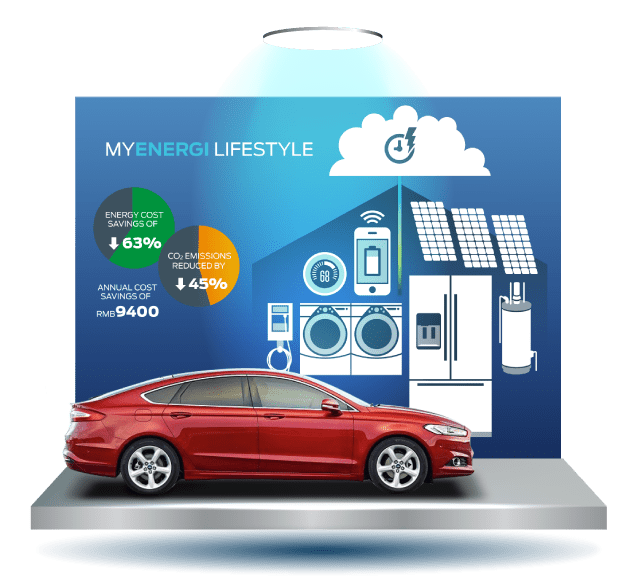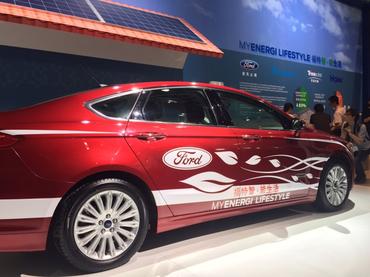Ford’s bold vision for the future of personal mobility is on display at CES Asia in Shanghai, with Ford Smart Mobility experiments, the latest in in-car connectivity technologies and the introduction of MyEnergi Lifestyle to China demonstrating Ford’s commitment to leveraging technologies to reshape how the world moves.
Ford is also announcing at CES Asia that it will open GoDrive to the public, a London-based car-sharing mobility experiment that will invite 2,000 members of the public to enjoy flexible, practical and affordable access to a fleet of 50 cars at 20 convenient locations throughout the city.
The Ford stand at CES Asia will feature displays of two Ford Smart Mobility experiments, the latest generation of its in-car connectivity solution, SYNC 3, the recently launched new Ford Focus, a MyEnergi Lifestyle showcase, the new Ford GT supercar and much more.
“Ford has been introducing groundbreaking innovations for over a hundred years, and at the core of that has always been a desire to improve the lives of millions of people all over the world,” said John Lawler, chairman and CEO, Ford China. “All the aspects of Ford Smart Mobility on display here today at CES Asia are just the latest in a long history of improving the driver experience and delivering personal mobility for the masses.”
Ford Smart Mobility is designed to anticipate the trends of tomorrow’s transportation ecosystem. The first phase of Ford Smart Mobility is a series of experiments that address four global megatrends – rapid population growth, expanding middle class, air quality and public health concerns, and changing customer attitudes and priorities – and seeks to tackle some of the challenges limiting personal mobility.
“What we’re doing with Ford Smart Mobility is really getting hands-on with the exciting tech that will redefine the customer experience and power our new era of transportation,” said Jim Buczkowski, director, Electrical and Electronics Systems, Research and Advanced Engineering, Ford Motor Company. “With the GoDrive London experiment, for example, we’re opening the program to the public, which will help us learn more about consumer needs and deliver the more efficient car-sharing system that drivers need and want.”

Car sharing, driven by consumer insight
Ford will initiate GoDrive, the second phase of its City Driving On-Demand mobility experiment – an exploration into car-sharing solutions which was announced earlier this year as part of Ford Smart Mobility – and invite 2,000 members of the public to experience the car-sharing service. The consumer-facing service will offer members access to 50 Ford vehicles available at 20 convenient locations around London.
Initial findings from the first phase of the experiment indicate that participants in car-sharing schemes consider one-way journeys, easy parking and simple pricing crucial components of a successful car-sharing program.
“We’re thrilled by the initial feedback from the GoDrive experiment, and are excited to work with even more drivers to learn how to best address their car-sharing needs,” said Buczkowski. “In today’s crowded cities, individual car ownership isn’t always the most affordable or convenient way to get around, and we’re experimenting in the U.S., Europe and Asia Pacific in order to optimize how car-sharing can increase mobility all over the world.”
In Bangalore, India, Ford is running a mobility experiment in conjunction with ZoomCar to explore car sharing in a closed community, with the goal of creating a model for easy vehicle sharing for groups like colleagues, apartment dwellers and families. This could help consumers who can’t afford a car – or don’t need one full time – experience the benefits of car ownership.
Currently, the Bangalore Car-Share experiment is running in three Ford EcoSports that have been equipped for data collection. The data collected throughout the ongoing project will be used to analyze trip information and user behavior to develop a model for vehicle scheduling and ownership management.
Sustainable consumption, enabled by MyEnergi Lifestyle
Ford and leaders in the home appliance, renewable energy and power management industries are launching the MyEnergi Lifestyle pilot program in Shanghai and Beijing, in order to demonstrate the real world impact of energy saving products. MyEnergi Lifestyle is a model that showcases how combining renewable energy sources, efficient home appliances and a plug-in vehicle can significantly reduce families’ energy costs and carbon footprint.
“Forging a trend of sustainable energy consumption is one of the major challenges we have ahead of us,” said Mike Tinskey, global director of Vehicle Electrification and Infrastructure, Ford Motor Company. “It’s not something that any single individual, product or corporation can achieve alone, which is why we’re so excited to work with experts like Haier, Trina Solar and Delta Electronics to develop a future that is more energy efficient in China and around the world.”
The MyEnergi Lifestyle model for China, created by Ford and researchers from the Georgia Institute of Technology, predicts approximate cumulative savings of 63 percent in energy costs – a 40 percent and 69 percent drop in electric and gasoline bills, respectively, for estimated annual savings of RMB 9,400 – and a 45 percent decrease in CO2 output, for a total reduction of 6,828 kg. The model also predicts a significant impact on reducing emissions that lead to pollution, including a decreased output of harmful PM2.5 and PM10 particulate matter by approximately 32 percent and 35 percent, respectively, and a reduction of both nitrogen oxide and sulfur oxide emissions by 38 percent.
Rethinking parking, powered by technology
At CES Asia, Ford is highlighting two mobility experiments: Remote Repositioning and Parking Spotter, both of which are underway in the U.S.
The Remote Repositioning experiment has outfitted a golf cart owned by the Georgia Institute of Technology – Ford’s partner on the experiment – with technology that allows them to be driven remotely, via a LTE streaming connection.
“Once equipped with the technology, the golf cart can be driven from a station that’s pretty similar to what you might find at a video arcade,” said Buczkowski. “There are some very exciting possibilities here, from improving car-sharing efficiency to simply allowing drivers to stay dry in bad weather.”
One potential outcome of the experiment would be the optimization of car-sharing programs, by using the technology to reposition cars that need to be relocated from where a driver left them to where a car needs to be for the next customer. The technology could also lead to a more affordable and widely available valet parking service.
Ford is also partnering with the Georgia Institute of Technology for another mobility experiment, Parking Spotter. This project leverages existing sonar and radar technology already available on Ford vehicles, and uses collected data to map parking information on the go. At speeds of less than 10 miles per hour, vehicles participating in the experiment act as roving probes and map open parking spots. This information is then uploaded to a cloud-based location, which drivers can access if they’re looking for a place to park. The Parking Spotter experiment has the potential to reduce parking anxiety and increase parking efficiency, especially in dense urban areas.
“The mobility experiments are great examples of how Ford is rethinking innovation in this technological age,” said Buczkowski. “Both of these projects as displayed as CES Asia are using existing technologies in new ways, and pushing the limits of what we can do to go further in improving mobility for all.”
China research projects, led by university alliances
Ford at CES Asia announced a research partnership with Chongqing University and the Chongqing Engineering Research Center of Intelligent Transportation Systems to develop a more accurate and predictive model to enhance multi-modal transportation systems. Using 8,900 buses equipped with GPS on 520 bus routes in Chongqing, the research project aims to reduce total travel time and energy consumption, and keep individuals better informed about wait times with more accurate real-time bus travel and arrival data.
“Most of the existing models that predict bus arrival times in China use the number of stops between the user and the nearest bus to calculate the estimated arrival time,” said Buczkowski. “Using real-time data will help streamline the scheduling system, and help commuters optimize their time in transit when connecting between different forms of transport, like the train or subway.”
Ford also announced a research effort that will explore consumer preferences in Beijing’s multi-modal transportation system. Working with researchers from the University of Michigan, Ford will build on a study conducted for Portland, Oregon, to examine transportation habits and preferences relating to driving, biking, walking and the use of public transport. The research in Beijing will survey over 2,000 people, cover the area of all six ring roads and include eight different modes of transportation.
Connectivity for the future, new AppLink partners
Visitors to the Ford booth at CES Asia will have the chance to interact with the latest iteration of Ford’s innovative in-car connectivity system, SYNC 3. The new system boasts faster performance, more conversational voice commands, a more intuitive touchscreen and an easier-to-understand interface to help customers control their in-car entertainment, climate settings, smartphone and more.
“With SYNC 3, Ford is delivering an easier way for drivers to stay connected to their lives on the go,” said Joe Beiser, director, Connected Vehicles and Services for Ford Asia Pacific and Europe. “Plus, with AppLink integration, Ford drivers have more ways than ever to safely use their favorite mobile apps while keeping their hands on the wheel and eyes on the road.”
Ford also announced at CES Asia three new partnerships to bring popular smartphone apps to the Ford AppLink platform: Ximalaya, Radio.cn and NetEase Music. Ximalaya is China’s leading provider of spoken audio entertainment, including news, audio books, stand-up comedy, radio programs and more; Radio.cn is an online public radio station that provides both live and on-demand programming from China National Radio; and NetEase is an online music streaming application.
Enhancements to Emergency Assistance, Ford’s subscription-free emergency feature that connects drivers to emergency operators via SYNC, will be brought to China. In the event of a collision where the airbag deploys or the fuel pump shut-off switch is activated, an emergency call is placed on the occupants’ behalf, announcing with a voice message that a Ford vehicle was in a collision, along with the GPS coordinates. With the enhancements being made to Emergency Assistance, Ford will now provide additional life-saving information, including the type of crash (front, side, rear or rollover), safety belt usage as detected by the vehicle, awareness of whether multiple impacts occurred and whether airbags were deployed.
“The enhancements we’re introducing to Emergency Assistance in China will deliver additional information to emergency responders, in order to better support drivers who have been in accidents,” said Beiser.
Visitors to the Ford booth at CES Asia will also be able to demo Ford AppLink, SYNC 3, get up close and personal with the new Ford GT supercar, and participate in a virtual reality SYNC 2 experience powered by Oculus Rift.
CES Asia 2015 will take place from May 25-27 at the Shanghai New International Expo Centre in Shanghai, China.












